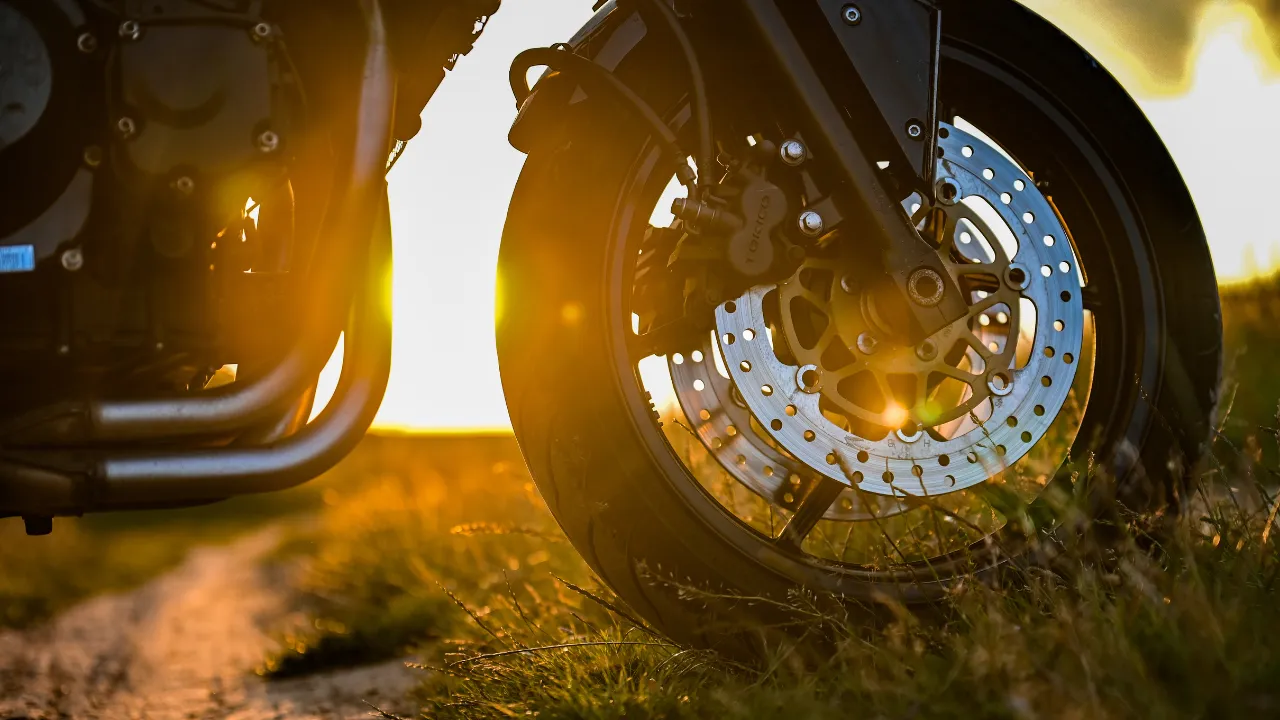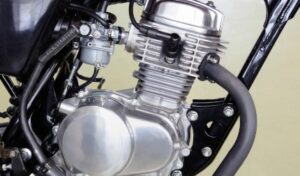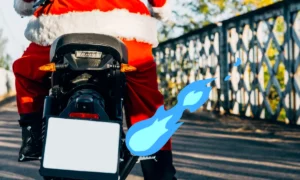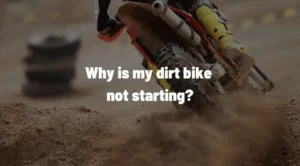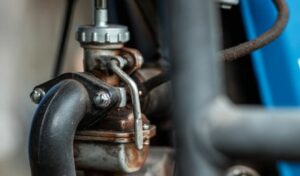When riding a motorcycle, dealing with gas leaks can be a challenge. Even though it happens more often with older motorcycles, it can still happen to brand-new motorcycles.
I’ve explained below the several reasons why a motorcycle gas leak can happen.
Do not overlook these six potential causes of a gas leak on a motorcycle, as well as the solutions to those problems, if you are currently experiencing difficulties and wish to eliminate this issue.
Why Is My Motorcycle Leaking Gas?
Motorcycle gas leaks can occur anywhere from the motorcycle gas tank to the carburetor or fuel injector, and the most common causes are loose hoses, old gaskets, and inadequate nut tightening.
The fuel petcock, carburetor, holes in the gas tank, and the fuel injector are the four most typical locations for motorcycle gas leaks.
It’s important to handle a motorcycle gas leak as soon as possible. Gas leaks can expose you to harmful odors, cause gas to get on your clothes, cost you money, and cause more damage to your motorcycle.
You may experience a lot of difficulties with motorcycle oil leaks as a rider, but I’ve covered how to solve that problem in a different post. To learn more about why a motorcycle leaks oil, click here.
Let us know all the potential causes of a motorcycle gas leak:
1. Fuel Valve
On a motorcycle, the flow of gas from the gas tank is controlled by the fuel valve. A butterfly handle or a ball valve can be used to regulate this valve.
A motorcycle’s fuel valve is the most typical location for a gas leak to occur. Not simply when the gas flow is turned on, the valve might leak at any moment.
The petcock gasket, which links the valve to the bottom of the gas tank, is the gasket that leaks from valves the most frequently.
They may also leak from its internal mechanism due of its small gaskets and o-rings, which are susceptible to brittleness over time.
The body of the petcock itself will start to emit gas as a result. Again, whether they are in the reserve, on, or off positions, these leaks can still occur.
2. Loose Fuel Lines
In addition to the gasoline petcock or fuel valve, the fuel line’s defective hose—which frequently becomes damaged while off-road driving or in busy traffic, where bumps are a typical threat to these lines—is usually the main cause of fuel leaks.
3. Carburetor
The motorcycle’s carburetor provides the engine with the precise air and fuel mixture it needs to burn and power the motorcycle.
If the gasket that sits on top of the carburetor bowl is brittle or damaged, a carburetor is far more likely to lose gas. The gas that is getting ready to be drawn into the engine is held in this bowl of the carburetor.
If the gasket isn’t doing its job, the gas can easily leak while it’s sitting there.
The carburetor has a drain plug at the bottom of this bowl that can also leak gas.
These plugs can occasionally come loose, mainly as a result of the motorcycle’s vibrations. To prevent fuel from leaking out of the drain plug, make sure it is tight.
Additionally, the gasoline connection between the carburetor and fuel line may leak in some cases with carburetors. Make sure the hose clamp is snug because that is what the issue is.
Your carburetors will be connected if you have a motorcycle with two, three, or four cylinders.
A gasoline bar may occasionally be present between the carburetor banks. On both sides of these fuel bars, there must be an o-ring. As an illustration, there will be two o-rings between carbohydrates 1 and 2, two more between 2 and 3, and so on.
Fuel will leak between these carb bank o-rings if any of them are damaged.
4. Holes In The Gas Tank
Gas leaks from motorcycles can, unfortunately, occur because of holes in gas tanks.
Most holes in gas tanks are caused by rust, but holes can also be caused by too much wear on the tank. Gas tank holes are particularly common on older motorcycles, and they are made more likely by living in humid environments.
A hole in the gas tank is probably at blame if you find gas dripping everywhere. Whether the motorcycle is on or not, this leak will never stop.
The location of the leak may appear random due to the fact that there are numerous components underneath the gas tank.
5. Fuel Injector
Recently, motorcycles have frequently used fuel injectors. They have demonstrated a good ability to produce the ideal air and fuel mixture that the motorcycle’s engine need in order to function.
The fuel injector is the least likely and least frequent source of gas leaks in motorcycles, yet it is nevertheless conceivable.
There is a fuel rail and injectors with o-rings within a fuel injector. The majority of the time, these components are strong and rarely leak.
However, if you’ve been inserting and removing these pieces frequently or if you’ve been working on the fuel injector, a gas leak is very likely.
6. Gas tank filler cap leak
Do you only smell or see a leak in your gas tank after you have recently refilled it with gas?
If this is the case, the gas tank cap could be the culprit.
Whenever the motorcycle is in motion, there is always a chance that fuel will escape from the tank’s top until the fuel supply is depleted to the point where it can no longer enter the tank.
The cap on your gas tank is old and worn.
How To Fix Motorcycle Gas Leak?
1. Dealing with the fuel valve
If you suspect the gas leak is from the valve but not sure if it’s the gasket or the valve itself, try replacing the gasket that goes between the petcock and tank first since it’s an easy fix.
Empty the gas tank and disconnect the petcock from the tank. Replace the small gasket that goes between the petcock and the gas tank.
You should be able to get the right part at an auto store or online for a few dollars.
Some petcocks don’t have a gasket. Some instead have the petcock threaded onto the gas tank.
If this is the case for you, get a fuel-resistant gasket maker and put it inside the thread to get a leak-free, tight fit.
Make sure the gas tank is empty when you use a fuel-resistant gasket maker and let it sit for 24 hours to cure before adding gas to the tank.
If you notice the leak is coming from the bottom of the petcock, likely, the hose clamp is not tight enough. This is also an easy fix and only requires you to tighten the clamp around the hose.
2. Replace faulty fuel lines
It is important to replace any fuel lines that are malfunctioning in addition to any clamps that are no longer holding the lines against the fittings.
3. Resolve gas leak between two carburetors
It is necessary to shine a light up inside the carburetor in order to identify which of the carb bank’s holes is leaking.
The next step is to remove the entire carburetor, disassemble it, and look for a damaged o-ring in the space between the two carburetor banks, which is where you discovered the leak.
If you find that all of the o-rings that connect the different banks of carburetors have grown worn, you should replace all of them.
In order to install the replacement gaskets in the carburetor, you will need to remove it from the motorcycle and disassemble it to some degree.
4 . Fixing the issue of holes in the gas tank
In the event that the hole in the tank is not clearly visible, you will need to slightly lift the tank off the motorcycle while keeping it connected to the fuel lines in order to pinpoint its precise location.
Dry everything underneath it so that when the leak does form, you’ll be able to spot it more simply.
In the event that your motorcycle’s gas tank does, in fact, have a hole in it, you will need to purchase a brand new tank.
It is not recommended that you try to fix the hole on your own by using a filler or welding it. Explosions are possible when you weld it.
If you really must have it welded, take it to a specialist who is experienced in dealing with issues of this nature.
5. Handling fuel injector issues
Because fuel injectors are electronic systems, they are significantly more intricate than carburetors, which are mechanical.
If you believe that your motorcycle’s fuel injector is the source of the gas leak, you will need to either take your motorcycle to a mechanic or purchase a new fuel injector entirely in order to fix the problem.
6. Fixing the gas tank cap
Changing the cap on the gas tank to the original model is all that is required.
Conclusion
Leaks of gas can be quite hazardous, and dealing with them correctly calls for the appropriate level of expertise, as well as the utilization of the appropriate equipment and methodology.
In addition to posing a significant threat to the rider’s well-being, the possibility of a gas leak from a motorcycle leads to a decrease in the vehicle’s gas mileage, an increase in the amount of gasoline that is consumed, and the loss of gas
Therefore, whenever you find yourself in this kind of circumstance, you should turn off the ignition of your motorcycle and switch off every available fuel valve on your machine. Then, you should take a moment to study the issue and determine how to fix it as soon as possible.
